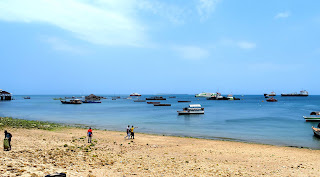We are in Zanzibar, Tanzania and to us it looks a lot like Morocco. For a couple of centuries Zanzibar was part of the Sultanate of Oman and at one point the sultan actually moved his headquarters to Zanzibar. (Before that the Portuguese were here and many others.)
So the island is mainly Islamic and has much the architectural flavor of the Middle East and other Islamic places.
It turns out that Zanzibar overthrew the sultan at around the same time that Tanganyika became an independent country (was a British Protectorate). Zanzibar, being a very small island nation, was concerned that they would not be able to defend themselves against Oman or other countries so decided to make an alliance with Tanganyika. The new country's name, Tanzania, was a combo of the two...Tan from Tanganyika, and zan from Zanzibar (plus ia to round out the name).
Zanzibar is an autonomous region that depends on Tanzania for defense and some other things while having some independent rule. History is fascinating.
This morning we have a walking tour of Stone Town in Zanzibar City. This area dates back many centuries but most of this main area dates from the 1600’s onward. Zanzibar was the main terminus for the East Africa Slave trade so we started at the Cathedral Church of Christ, an Anglican church that was built on the site of the main slave market.
Next door was a haunting memorial to the slaves.
There was also a very good museum about slavery that covered its history in the area.
Adjacent to the museum was a pair of holding cells that were used to hold slaves that were going up for auction. The one for women and children “held” 75 to 80 (in horrendously cramped conditions and the one for men held about 50. It was positively inhuman. (When it was in use the rooms didn't have the large concrete "benches". Those were added later to reinforce the building.)
From there we did a walking tour that took us through the narrow streets (reminded us a bit of Morocco)
*************************************
More Zanzibar City
*************************************
to a markets.
*************************************
More Zanzibar Markets
*************************************
Next door was the meat market (didn’t really visit that) and the fish market.
Zanzibar used to be part of the Sultanate of Oman and we saw the palace of the Sultans, now government offices.
Just like in Morocco, the doors are dominant here in Zanzibar. The façade of a building may look pretty ordinary but the doors are interesting and usually lead to very lovely interiors (not that we got to peak inside any of these doors).
Turns out there are two types of doors here...Arabic (flat tops) and Indian (round top). Indian traders have been visiting Zanzibar for many centuries and have contributed the the overall architectural esthetic. (And there are a number of Hindu temples scattered around town.)
Note: The that there many small round items on the doors. These are actually spikes. Those come from Indian design. The spikes are to keep elephants from ramming down the door with their heads. There are no elephants in Zanzibar but the spikes were retained on many of the designs.
The tour ended at
the hotel around lunch time. It was
interesting but the day was hot and humid so we were both glad to get back to
the hotel.
The waterfront from our hotel.











































No comments:
Post a Comment